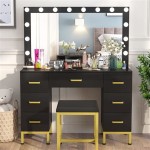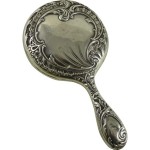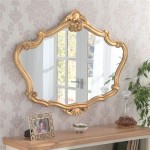Hanging Heavy Frameless Mirrors
Frameless mirrors offer a sleek, modern aesthetic, enhancing spaces with light and a sense of openness. However, their lack of a traditional frame presents unique challenges when it comes to installation, especially for larger, heavier pieces. Proper hanging techniques are crucial to ensure both safety and the longevity of the mirror.
Key Considerations Before Hanging
Several factors should be considered before attempting to hang a heavy frameless mirror:
- Weight and Size: Accurately assess the mirror's dimensions and weight to select appropriate hanging hardware.
- Wall Type: Determine the wall construction (drywall, concrete, brick, etc.) as this dictates the type of anchors and fasteners required.
- Location: Consider the desired height and placement of the mirror, ensuring adequate wall space and accounting for any obstructions like electrical outlets or plumbing.
- Mirror Backing: Examine the back of the mirror for existing hanging hardware or designated mounting points.
Essential Tools and Materials
Gathering the necessary tools and materials beforehand streamlines the hanging process:
- Measuring Tape: Precise measurements are vital for proper placement and alignment.
- Level: Ensuring the mirror hangs perfectly straight is essential for a professional finish.
- Pencil: Marking the wall for drilling or anchoring points is crucial for accuracy.
- Drill (if necessary): Required for installing anchors into certain wall types.
- Appropriate Anchors: Choose anchors designed for the specific wall type and weight of the mirror. Examples include toggle bolts for hollow walls and concrete screws for masonry.
- Screws or Bolts: Select fasteners compatible with the chosen anchors and capable of supporting the mirror's weight.
- Mirror Adhesive (Optional): Can provide additional support and security, particularly for heavier mirrors.
- Safety Glasses and Gloves: Protect eyes and hands during the installation process.
Choosing the Right Hanging Method
Several methods are suitable for hanging heavy frameless mirrors, each with its own advantages and disadvantages:
- J-Channels or Z-Clips: These specialized clips offer a secure and discreet hanging solution. J-channels are mounted to the wall, and the mirror slides into place. Z-clips involve one clip attached to the wall and another to the back of the mirror. They are suitable for various wall types and offer adjustability.
- Mirror Mastics or Adhesives: These specialty adhesives are designed to bond with both the mirror and the wall, providing a strong hold. This method eliminates the need for visible hardware but requires careful application and precise placement.
- Heavy-Duty Mirror Hangers: These hangers are designed specifically for heavier mirrors and are often rated for specific weight capacities. They typically involve a plate attached to the wall and hooks or clips that engage with the back of the mirror.
Step-by-Step Hanging Process (Using J-Channels as an Example)
While specific steps may vary depending on the chosen hanging method, the following provides a general guide using J-channels:
- Measure and Mark: Carefully measure the width of the mirror and mark the desired location on the wall. Use a level to ensure the lines are perfectly horizontal.
- Install J-Channels: Secure the J-channels to the wall along the marked lines, using appropriate anchors and screws. Ensure the channels are level and securely fastened.
- Prepare the Mirror: Clean the back of the mirror where it will contact the J-channels to ensure a secure fit.
- Carefully Insert the Mirror: With assistance, carefully lift and slide the mirror into the J-channels. Ensure the mirror is fully seated and secure.
- Check for Stability: Gently push on the mirror to confirm it is firmly in place and does not wobble.
Safety Precautions
Safety should be the utmost priority when handling and hanging heavy objects like mirrors:
- Work with a Partner: Enlist the help of another person, especially for large or heavy mirrors, to prevent accidents and ensure proper alignment.
- Use Proper Lifting Techniques: Bend at the knees and lift with your legs, not your back, to avoid injury.
- Wear Protective Gear: Always wear safety glasses and gloves to protect against potential hazards.
- Inspect the Wall: Ensure the wall is structurally sound and capable of supporting the weight of the mirror. If in doubt, consult a professional.
- Follow Manufacturer's Instructions: Always refer to the manufacturer's recommendations for specific hanging hardware and installation procedures.
Post-Installation Considerations
After the mirror is hung, a few final checks are recommended:
- Final Level Check: Double-check the levelness of the mirror after installation.
- Cleaning: Clean the mirror surface with a suitable glass cleaner.
- Periodic Inspection: Periodically inspect the hanging hardware and mirror for any signs of loosening or damage.

How To Install A Mirror Without Frame Merrypad

How To Hang A Frameless Mirror On The Wall With Pictures

How To Hang A Frameless Mirror On Wall
:strip_icc()/DesireeBurnsInteriors1-f76d25cad90041c88fbae4a7dc10aab4.jpg?strip=all)
2 Simple Ways To Hang A Frameless Mirror

How To Hang A Hanging Mirror Without Accompanying Hardware

How To Install A Mirror Without Frame Merrypad

How To Hang A Frameless Mirror June 2024 Your Guide Hanging
:strip_icc()/ScreenShot2022-04-28at1.12.19PM-e055476c70c6438585fa7c5cd531edcf.png?strip=all)
4 Easy Ways To Hang A Heavy Mirror

How To Hang A Large Wall Mirror Step By Tutorial

How To Hang A Frameless Mirror On Wall








